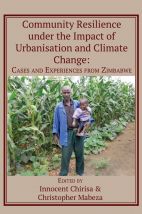Community Resilience under the Impact of Urbanisation and Climate Change: Cases and Experiences from Zimbabwe

In the global South, there is a pressing need to enable and promote resilience to cope with the chronic stresses and acute shocks associated with urbanization and climate change. Community Resilience under the Impact of Urbanisation and Climate Change highlights the need to conceptualize community resilience in Zimbabwe, with a focus on the use of indigenous knowledge and survival of vulnerable groups.
The book identifies three forms of inputs into community resilience. Firstly, physical enablers provide the means to survive and recover. Secondly, procedural enablers provide the ideas, policies and plans on how to survive and recover. Thirdly, social enablers (for example, social cohesion) provide the will to survive and recover. Combined, these enablers result in different resilience capacities: absorptive, adaptive and transformative. The book argues that vulnerabilities have differential impacts on groups, depending on the different resilience capacities a group possesses.
The volume contains 11 chapters dealing with multiple dimensions of resilience in various Zimbabwean contexts. Chapter 2 proposes “consilience”, particularly between local and scientific knowledge systems, as a step towards building community resilience to the impacts of climate change.
Chapter 3 demonstrates the lower resilience capacity of child-headed households in Buhera District, propounding the need to incorporate child-centred perspectives into climate policymaking and improve social work interventions related to the effects of climate change.
Chapter 4 deals specifically with urban resilience in Harare, focusing on five key pillars: urban governance, urban planning and environment, resilient infrastructure and basic services, urban economy and society, and urban disaster risk management.
Chapter 5 investigates the lives of street children in Harare and the activities and behaviours they engage in to develop resilience in a harsh context. It recommends reform of the family system, along with improved education and vocational training for street children to minimize their numbers and provide pathways for employment and resilience.
Chapter 6 calls for the implementation of the Sustainable Development Goals to build resilience through transformative capacities, highlighting the need to shift focus from absorptive and adaptive humanitarian assistance.
Chapter 7 investigates local approaches to weather forecasting based on examining the behaviour and appearance of flora and fauna.
Chapter 8 presents findings from an ethnographic study of two rural villages, including the obstacles to successful adaptation faced by the village communities and the adaptive strategies that farmers have adopted.
Chapter 9 applies a livelihoods framework to explore the politics of community resilience as it applies to settlement hierarchies in Zimbabwe.
Chapter 10 illuminates the adverse perceptions of climate change among rural smallholder farmers based on their negative experiences of externally fostered small grains production, promoted as an adaptive strategy and response to climate change impacts.
Finally, Chapter 11 uses the cases of urban agriculture in Harare and Havana, Cuba to exemplify how a tumultuous economic climate can drive innovation for food security and survival for urban residents.
Book note prepared by Kate Goh
Search the Book notes database
Our Book notes database contains details and summaries of all the publications included in Book notes since 1993 - with details on how to obtain/download.
Use the search form above, or visit the Book notes landing page for more options and latest content.
For a searchable database for papers in Environment and Urbanization, go to http://eau.sagepub.com/

